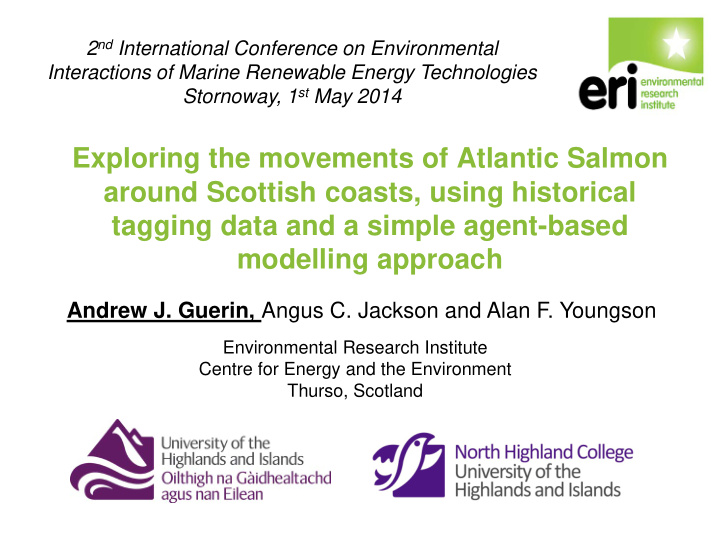



2 nd International Conference on Environmental Interactions of Marine Renewable Energy Technologies Stornoway, 1 st May 2014 Exploring the movements of Atlantic Salmon around Scottish coasts, using historical tagging data and a simple agent-based modelling approach Andrew J. Guerin, Angus C. Jackson and Alan F. Youngson Environmental Research Institute Centre for Energy and the Environment Thurso, Scotland
Atlantic Salmon, Salmo salar Anadromous • Hatch in freshwater, resident for 1-3 years • Migrate to marine feeding grounds in the North Atlantic for 1-5 years • Return to natal rivers to spawn Under threat from anthropogenic impacts • Pollution of freshwater habitats • Hydropower (rivers) and dams • Marine fisheries • Climate change Populations are in decline Source: Chaput, G. ICES J. Mar. Sci. (2012) doi: 10.1093/icesjms/fss013
Marine Renewables in Scotland Scottish Government target: “to meet an equivalent of 100% demand for electricity from renewable energy by 2020” 2020 Routemap for Renewable Energy in Scotland http://www.scotland.gov.uk/Publications/2011/08/04110353/0 Environmental implications currently uncertain
Possible effects on salmon? ? ? ?
How likely are fish to encounter arrays? Pentland Firth • Significant tidal and wave energy potential • Four testing sites (European Marine Energy Centre, Orkney) • 12 seabed leases granted by Crown Estate • 4 tidal sites in the Pentland Firth itself • Consent granted for deployment at one tidal Source http://www.thecrownestate.co.uk site
How likely are fish to encounter arrays? How many fish pass through the Pentland Firth (or other areas of interest to the renewables industry)? How many fish pass through specific array sites?
Return migration of adult salmon Three phases OCEANIC COASTAL RIVER Return from distant Movement around Fish move up their waters to UK coastal Scottish/UK home rivers in search seas coasts as fish of spawning sites seek home rivers
An agent-based ‘cellular’ model Scotland is divided into 109 Fishery Districts • Catch and effort statistics recorded • Fish caught in • Coastal ‘fixed engine’ net fisheries • Rivers by ‘net and coble’ and ‘rod and line’ Assumption: once fish arrive at the coast, they follow the coast, passing through each district in sequence as they search for their home river. Image source: http://www.scotland.gov.uk/Publications/2012/09/5760
An agent-based ‘cellular’ model This allows us to represent the coastal waters as a linear series of ‘cells’ (blue cells in the model ‘world’ below). The rivers of each district can also be represented as a parallel series of cells (green cells). Kishorn district, 65 Tweed district, 101 Coloured arrows indicate corresponding locations on map and model ‘world’
An agent-based ‘cellular’ model Model coded using NetLogo. • ‘Fish’ can be placed in the coastal water of one (or more) district, and given a ‘home river’ ID. • ‘Home river’ IDs represent the district in which the fish hatched • These IDs are assigned on the basis of the productivity of the rivers of each district (ie. Larger river systems contribute more to the population of model fish).
An agent-based ‘cellular’ model At each time step: • If fish are in the coastal waters of their home river, they may enter it (50% chance) • Otherwise, fish move towards their home river (15% chance), or randomly. • Additionally, at each time step, fish in coastal waters have a fixed probability of being captured in coastal net fisheries
Initial model runs First runs: • 141 fish released from Inchard district • Model runs until all fish: • are captured by a coastal fishery, OR • successfully return to their home river • Final positions of all fish recorded • Repeated 10 times Inchard district, 56
Model output COASTAL FISHERIES CATCH Note – all x-axes labels are sequential cell numbers – these do not correspond to district numbers on the map FISH RETURNING TO RIVERS
Real data: Historical fish tagging experiments Fish tagging experiments in Scotland Early 20 th Century (even late 19 th century) up to 1970s • • Work initially conducted by Inspector of Salmon Fisheries for Scotland • W.L. Calderwood • W. J. M. Menzies • Tag-recapture exercise • Fish caught in coastal netting stations • Tagged, released • Recaptured by coastal fisheries, river nets and anglers • Couldn’t be repeated today (not enough coastal fishing effort)
Real data: Historical fish tagging experiments Fish tagging experiments in Scotland 1914 – Learnie station 1915 – Kintradwell 1920 – Thurso 1936 – Loch Inchard 1937 – Raffin 1952 – Altens 1954-55 – Rockhall 1977-78 – Rockhall 1978-80 – Macduff 1981-83 – Buckpool & Boar’s Head Summarised by Malcolm et al. 2010: Review of migratory routes and behaviour of Atlantic salmon, sea trout and European eel in Scotland's coastal environment: implications for the development of marine renewables
Model vs data Loch Inchard 1936 data MODEL OUTPUT ACTUAL DATA Numbers of fish captured
Model versus additional real data Left-hand charts: MODEL Right-hand charts: DATA Green bars – ‘ANTI-CLOCKWISE’ migration Yellow bars – ‘CLOCKWISE’ migration
More data: coastal versus river recaptures Blue bars (left) coastal recaptures, Green bars (right) river returns MODEL DATA MODEL DATA Inchard Altens Spey Macduff Raffin Rockhall (1970s) OK MATCH POOR MATCH
Further model-data comparisons MODEL DATA SPEY INCHARD Left bars (black) – West Coast recaptures Centre bars (light grey) – North Coast recaptures Right bars (dark grey) – East Coast recaptures
Conclusions A simple ABM can represent some features of the coastal migration of returning adult salmon in Scotland. Other features are currently not well reproduced. Problems with model assumptions? • Composition of fish wrong at start? • Simple linear passage too simple? • Need alternate starting points? Problems with underlying data? • Uniform coastal fishing effort is not realistic • Use of recent fishing data for river productivity But the model can be modified to explore the alternatives!
Thank you for your attention! Presentation can be viewed and downloaded at www.slideshare.net/andrewjguerin Thanks to: Marine Scotland Science (in particular, Jason Godfrey, Stuart Middlemas, Julian MacLean and Gordon Smith) for helping us with access to tagging data Work supported by The Crown Estate Marine Renewable Energy and the Environment (MaREE) project
Recommend
More recommend